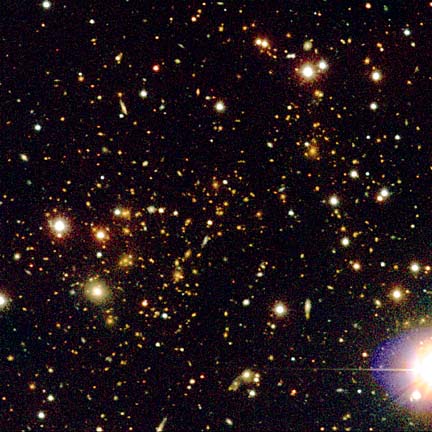Advertisement - Click to support our sponsors.


Distant galaxy Two University of Hawaii astronomers and a British colleague have discovered 101 giant galaxy clusters so distant they could change thinking about the evolution of the universe.
clusters may change
ideas of how the
universe evolved
UH astronomers say such
clusters help determine whether
the universe will continue to expandBy Helen Altonn
Star-BulletinOne of the most distant is 8 billion light-years away, said Harald Ebeling of the UH Institute for Astronomy.
Commenting on the discovery, William Forman, of the Harvard-Smithsonian Center for Astrophysics, said the clusters are "the largest collapsed objects in the universe ... the rarest things that collapse."
They are so rare that they are very hard to find even with X-ray observations. With their discovery, Forman said, "We can make sense of the sky in a statistical manner."
Ebeling, UH astronomer J. Patrick Henry, and Alastair Edge of the University of Durham are searching for galaxy clusters in a five-year "Massive Cluster Survey" (MACS) funded by the National Aeronautics and Space Administration.
"It would be extremely difficult to do the work except at the University of Hawaii," Henry said, noting how UH astronomers have extensive access to Mauna Kea telescopes to find and study far-off clusters of galaxies using X-ray observations.
The team's findings on galaxy clusters were among major presentations at meetings of the American Astronomical Society's High Energy Astrophysics Division this week at the Ilikai Hotel. Henry headed the local organizing committee.
Giant galaxy clusters are extremely rare and difficult to spot at great distances without use of X-ray data, Ebeling said.
The massive clusters are bound together by the force of gravity -- the largest such structures in the universe. Typically, they contain a few hundred to thousands of galaxies, each of which contains many billions of stars.
"MACS has been mind-bogglingly successful at finding the elusive massive, distant galaxy clusters," Ebeling said. "The high discovery rate of MACS means that there are many more of these systems out there than was previously thought, and this has profound cosmological implication."
Hundreds of nearby clusters have been known, the astronomers noted, including "poor groups," such as the Milky Way, and rich systems, such as a massive cluster in the Coma constellation about 500 million light-years away.
"The more distant clusters, however, hold the key to understanding how clusters form and evolve," the scientists said. "Finding these systems had been a major observational challenge until the advent of superior X-ray observatories."
With few such clusters detected in the past, scientists believed they weren't common and must have formed relatively late in the history of the universe -- perhaps as "recent" as 3 billion years ago.
However, detection of the massive galaxy clusters indicates the systems began to form when the universe was only half of its present age, the Hawaii group said.
"They challenge our current understanding of how quickly the universe evolved into its current hierarchical structure of stars, galaxies and clusters."
The astronomers are using All-Sky Survey data from ROSAT, a German X-ray satellite operated in collaboration with the United States and United Kingdom until December 1998.
Spanning most of the sky with the observations and telescopes at Mauna Kea enabled the astronomers to find the most extreme massive clusters. Even the Hubble Space Telescope couldn't see them because it looks at a small fraction of sky, Ebeling said.
The orbiting Chandra X-ray Observatory, Subaru and Keck telescopes on Mauna Kea and the BIMA array of nine radio telescopes in Northern California have begun detailed follow-up studies of the new-found clusters.
Edge said the information can be used for accurate measurements of the density of matter in the universe (known as omega), which is the most important goal in observational cosmology.
While the analysis isn't complete, "it is already clear that our observations are in conflict with a high value of omega," Edge said.
The value of omega helps scientists to determine whether the universe will expand forever or collapse upon itself. Evidence thus far indicates the universe will continue expanding.
Ebeling said the study of the clusters is fascinating because they contain large quantities of dark matter, which contributes far more to the overall cluster mass than all galaxies and gas together.
He said the close coexistence and interaction in clusters of three prime components of the universe -- galaxies (or stars), gas and dark matter -- "make clusters wonderful astrophysical laboratories."
UH Institute for Astronomy